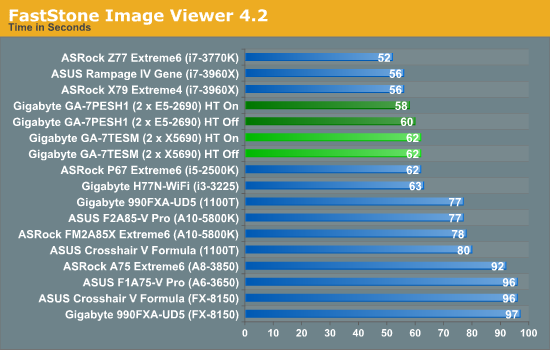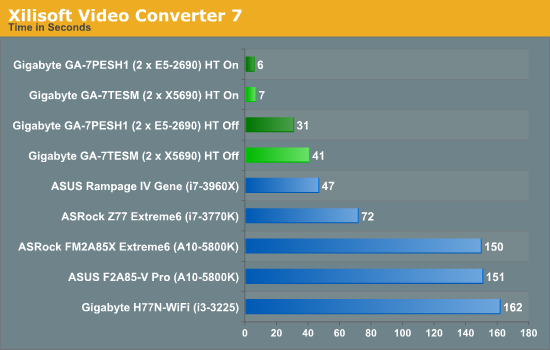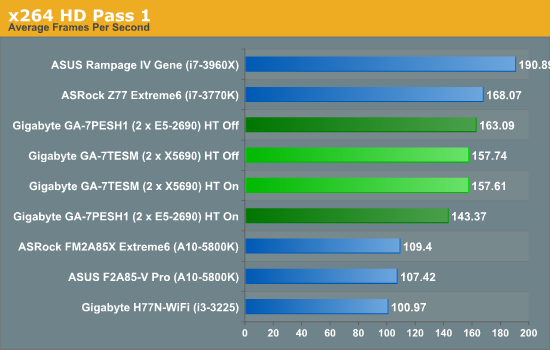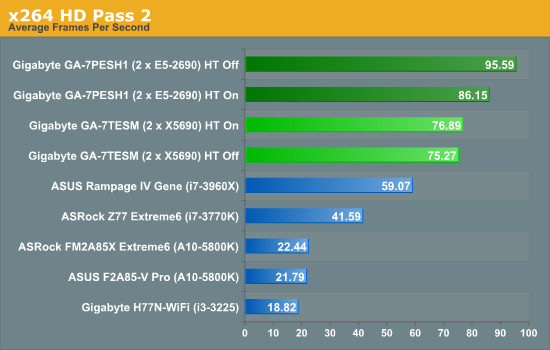Westmere-EP to Sandy Bridge-EP: The Scientist Potential Upgrade
by Ian Cutress on March 4, 2013 9:30 AM EST- Posted in
- CPUs
- Xeon
- Westmere-EP
- Sandy Bridge-EP
For completeness, we run our normal motherboard benchmarks.
WinRAR x64 3.93 - link
With 64-bit WinRAR, we compress the set of files used in the USB speed tests. WinRAR x64 3.93 attempts to use multithreading when possible, and provides as a good test for when a system has variable threaded load. If a system has multiple speeds to invoke at different loading, the switching between those speeds will determine how well the system will do.

Despite the slight memory difference between the two platforms, using E5-2690s with HT off has a significant 29% advantage over HT being on or the X5690 results.
FastStone Image Viewer 4.2 - link
FastStone Image Viewer is a free piece of software I have been using for quite a few years now. It allows quick viewing of flat images, as well as resizing, changing color depth, adding simple text or simple filters. It also has a bulk image conversion tool, which we use here. The software currently operates only in single-thread mode, which should change in later versions of the software. For this test, we convert a series of 170 files, of various resolutions, dimensions and types (of a total size of 163MB), all to the .gif format of 640x480 dimensions.

With the single thread speeds being similar, the only separation between our systems should be IPC – and thus as expected the Sandy Bridge-EP system is ahead, but only by 3-6%.
Xilisoft Video Converter
With XVC, users can convert any type of normal video to any compatible format for smartphones, tablets and other devices. By default, it uses all available threads on the system, and in the presence of appropriate graphics cards, can utilize CUDA for NVIDIA GPUs as well as AMD APP for AMD GPUs. For this test, we use a set of 32 HD videos, each lasting 30 seconds, and convert them from 1080p to an iPod H.264 video format using just the CPU. The time taken to convert these videos gives us our result.

With XVC having many threads is what counts, meaning that 24 threads on a full X5690 system will equal our small video conversion test. At this level, we would need more content to see significant difference. With HT off however, the Westmere-EP result is nearer that of a single 3960X than the E5-2690s.
x264 HD Benchmark
The x264 HD Benchmark uses a common HD encoding tool to process an HD MPEG2 source at 1280x720 at 3963 Kbps. This test represents a standardized result which can be compared across other reviews, and is dependant on both CPU power and memory speed. The benchmark performs a 2-pass encode, and the results shown are the average of each pass performed four times.












44 Comments
View All Comments
alpha754293 - Tuesday, March 5, 2013 - link
Sorry, I'm back. Where was I? oh yes...Unless that you were purely running single-threaded, single process jobs (or maybe even lightly multithreaded, single process jobs) - I would think that to say that it is favouring a single-CPU system might be a little bit misleading.
Even with single-socket systems, if it's got multiple cores, then you can parallelize amongst those as well.
Some commercial programs too favour 2^n cores as well, which would make quite a difference between having 8- or 16-cores vs. 6 or 12 (because some programs won't even run properly if it isn't 2^n).
Also it was interesting to see that you didn't run the implicit 3D grid solver benchmark.
Actually, MPI might not has as much to do with memory than you might think. Considering that the world's top supercomputers haven't maxed out the memory capacity per socket, I doubt that. It IS, however, much better at the actual parallelization of the task than OpenMP.
"‘Is moving from Westmere-EP to Sandy Bridge-EP a reasonable upgrade’, in the majority of our scenarios it probably is not"
It really depends. If you're writing your own code (which is what you're doing), and you have a lot of control over it, then that MIGHT be a true statement. (And it also depends on the state of your code too. If you're almost always in a permanent alpha phase (because you keep adding new capability and modules to it), then chances are, you might not even get around to parallelizing it (because you want to make sure that the base solver is robust first before you add the additional complexity of parallelization on top of that).
But if, say, suppose that you're doing research on crash and crash safety; and you're using a commercial code - some of those would just favour more cores period (see Johan's latest benchmark on the Opteron for details).
And as to whether or not you can run it on a GPU; the problem with that is that you have to make sure that every system in your working/research group has the same capable GPU hardware; otherwise, those that don't can't even run it, and those that have lesser-capable GPUs - might not get the benefits of using a GPU as much as you think, if at all.
(My GTX 660 OC's double precision performance is actually slightly SLOWER than the double precision performance of my 3930K OC'd to 4.5 GHz.)
alpha754293 - Tuesday, March 5, 2013 - link
Also, as far as I know/can remember - not everything can make use of AVX - both in terms of programs and also in terms of fundamental math operations.And I would suspect that you might also have slight performance variations if you were to recompile on the Sandy Bridge vs. on the Westmere-EP platforms (rather than sharing the binaries between the two - unless you purposely don't make it target specific).
wingless - Monday, March 4, 2013 - link
Somebody on my folding team is building this setup with dual Titans as a folding/gaming rig. The ultimate in computation, gaming, and space heating!yougotkicked - Monday, March 4, 2013 - link
I just wanted to say I found this analysis rather interesting. I'm a undergrad CS major, but I work in the IT office for the chemical engineering and material science dept. at a research university, so this breakdown of the relationship between simulations and hardware was really fascinating for me.Just to give some perspective on the pricing of an OEM-built system using E5-26XX parts, one of the research groups I work with recently bought a dual E5-2687W system from HP with 128 gigs of ram, liquid cooling, and a mid-range workstation GPU; The whole system came in at over $10,000. admittedly this includes a ~$1000 monitor and 4 hard drives, but this is probably at least a 30% margin over the cost of hardware, so the 10% margin used in the article may be on the conservative side.
P.S. we didn't suggest that system to the researchers, they bought it on their own.
colonelpepper - Monday, March 4, 2013 - link
HP & Dell systems are much more expensive than the same system built by a "system integrator" <-- I believe that's what they're calledI've read in other forums that system integrators building you a custom system add about 10% to the price tag.
yougotkicked - Monday, March 4, 2013 - link
That sounds reasonable, my only gripe would be that many researchers would not seek out a system integrator and just turn to a big name like HP. Had they sought the advice of the IT office I would have suggested we build it in-house for no markup at all.Kevin G - Monday, March 4, 2013 - link
Dell and HP's workstation lines carry a much higher premium than what you'd get DIY. The difference is in their warranties. Since dual socket workstations are effectively using low end servers in a tower chassis and they'll offer warranties very similar to what you can get for a 24/7/365 running server. While I'm not a big fan of Dell's hardware, I will say that they do follow through on their warranties. I've seen them get a replacement hard drive to my facility in under 4 hours as that is the level of support I was paying for. It wasn't cheap but it was worth it considering the business need.With the scientific slant, such warranties may turn out to be overkill as is going with OEM's. You'd still want to have the necessary data protections in place like ECC memory, redundant storage and a good backup policy while the simulation is running. However, what is the worst case that could happen when something does go wrong with the basic protections in place? Generally it is simply running the simulation again. Time is money and there are often some deadlines to meet. So if the simulation can't realistically be run again or it'd cost to much to run again, then going with an OEM that'll help achieve greater uptime is worth it.
As for the price of some of these components individually, I'm about to drop ~$1000 USD on a 128 GB memory upgrade. OEM's like Dell and HP get such parts far cheaper than DIY users due to bulk purchasing power. It is far higher than 10% margin for them in terms of raw hardware costs.
IanCutress - Tuesday, March 5, 2013 - link
The dual E5520 systems from Dell (with 4GB RAM because research department limited us to XP 32-bit) I used for research, with basic storage and a monitor each, ran up to £2k per order back in 2009. After a month of waiting to be delivered (after tons of initial hassle with the department IT guy), it turns out the systems arrived shortly after ordering and our IT guy had decided to hide them in a different building on campus and 'forgot to tell us'. The monitors were in a building the other side of campus. Fun fun fun! Needless to say, we were all rather annoyed. But looking back, I should have just asked for a single powerful Xeon workstation.yougotkicked - Tuesday, March 5, 2013 - link
Yikes, sounds like your IT guy needs to get his act together. We'd never get away with that kind of stuff here.My university has a few super-computing clusters available for researchers running truly large simulations, but because of that many groups choose not to buy systems powerful enough to run their mid-sized simulations and the clusters are usually booked a while in advance. The HP system was purchased primarily because the group was sick of waiting for their simulations to get a turn on the supercomputers.
If only there were a folding@home style client that researchers could easily program for, we could turn our computer labs into compute clusters at night.
colonelpepper - Monday, March 4, 2013 - link
This would be a very poor time to spend thousands of dollars on a high-end 2600 CPUs!The Xeon 2600 series is getting a refresh soon, better to wait and get more CPU for your buck... unless you're dying to spend big $$ now that is:
http://2.bp.blogspot.com/-zhrS1C8wbk0/UHj_HxsrMTI/...
that link is to the largest image I could find of Intel's Xeon Roadmap that was leaked late last year